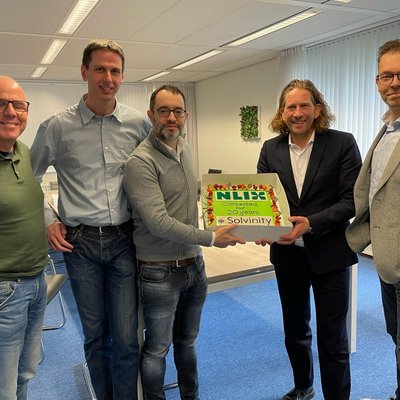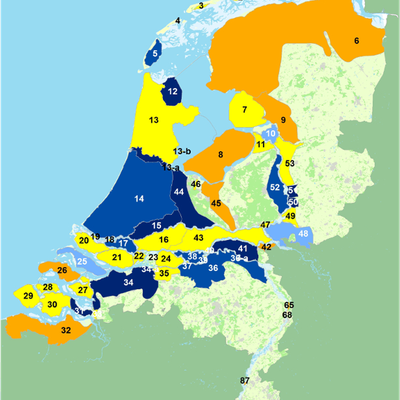
23 years of NL-ix
Founder Jan takes us through the times
Happy birthday to us! To commemorate the 23rd birthday of NL-ix, our founder Jan Hoogenboom reflects on how the company and landscape has changed since its humble beginnings, and makes some predictions on the future.
Looking back on the NL-ix story, it's quite something to see how we've grown from a small setup into a key player in the Internet Exchange sector. Back in the day, it was just my co-founder and I trying to figure out how to shake up the Internet Exchange world.
Over the past 23 years, NL-ix has navigated through numerous shifts in the tech landscape, and here we are, right in the middle of yet another significant transition.
What happens when your key product becomes 1000x cheaper.
When we started, Internet Exchanges were a huge game-changer. They transformed how we managed Internet traffic, making it possible to bypass expensive routes and significantly cut costs.
Just imagine, traffic that once had to take a pricey detour through America could now be exchanged locally at a fraction of the cost—making operations not just faster and more reliable, but also dramatically cheaper. This innovation was revolutionary, putting Internet Exchanges at the heart of digital infrastructure development.

But as the digital landscape became more complex, so too did the dynamics of cost and efficiency. The massive cost advantage we once enjoyed has diminished over time. Today, whether you opt for Transit or Peering, like we offer at NL-ix, the cost differences have narrowed significantly.
This shift has been a clear sign that it's not just about the price anymore. It's a reminder of how our industry has transformed and how our focus has shifted from merely reducing costs to enhancing quality, reliability, and meeting the future needs of our clients.
Leading change, not following trends.
As NL-ix has grown, so has the way we operate—and my role within the company. These days, I'm much more involved in charting our course, looking at the big picture of what businesses need and, more importantly, where we're all heading.
The heart of my job has become about foresight—envisioning what NL-ix will be doing in the next 3 to 5 years for our clients.
In the past, our main clients were Internet providers, hosters, and frontrunning tech-savvy enterprises. Over time, however, we've seen a significant shift, especially in the last three to four years, where we've focused more on the enterprise side of things for our clients. Why this shift? Today, the average business not only uses cloud infrastructures but also relies on countless cloud-based SaaS applications. This range includes everything from online accounting software and leave management systems to critical tools like Salesforce and ServiceNow.
Companies have become incredibly dependent on these external cloud applications for their daily operations. Access to these applications, of course, comes through the Internet. So, gone are the days when an Internet connection was a nice-to-have, used mainly for browsing news sites or sending emails that could afford a slight delay. Now, that Internet connection has become mission-critical.
Out of the 150 applications a typical company uses, dozens are absolutely vital. For instance, some banks have moved to video banking, which means banking consultants and customers interact via screen. If the connection is poor or fails, customers might as well go back to traditional banking methods. This means the innovations we aim to implement in the business sector heavily depend on the availability and reliability of the underlying Internet infrastructure. In other words: they heavily depend on us.
Internet Flows.
Suddenly, we've become crucial to the business market, providing the control and oversight needed over their Internet infrastructure. We've become the interface between companies, their employees, and the vast, sometimes daunting external digital world.
With our ‘Internet Flows’ technology we can actually give the customer single hop end-to-end direct connectivity as well as deep insight into his traffic streams to over 2,400 Internet applications and networks (for most enterprises comprising 90-95% of their critical traffic) including geographical routing paths and termination, (ultra-low) latency and current and historic traffic levels. The Internet no longer need to be a black box.
For over 20 years, what we've excelled in—offering a broad spectrum of services not just limited to Peering but extending to all other needs required to connect with the external world—has become essential. We're here to bring those vast online applications under control for businesses, ensuring they have the reliable access they need to operate smoothly.
You could say that we've started doing something different from the rest of the providers in the market, right? We've moved towards the customer. We're now much closer to the customer and their needs.
All aboard the internet-slicing bus.
Our customers want, or better need, to be an integral part of the new digital world and all the innovation opportunities the digital transformation brings, and inherently part of the Internet, and enjoy the autonomy that comes from not being dependent on their provider. This autonomy gives you a lot of control and insight, but ideally, you'd want to simplify the complexity behind it. That's where our automation comes into play. We infuse our expertise into automation to simplify these complexities for our customers.
In the past, getting Internet from a provider was like riding on a bus. You'd sit in the back while the driver decided whether to turn left or right, with no input from you. All the provider's customers were on the same journey. What we do with our service is essentially put you back in the driver's seat of your own car. We still act as your navigator, or even your private chauffeur, but you're the one who decides which way to go, giving you control over your route. You no longer just ‘connect’ to the Internet (via an ISP), you are now ‘part’ of the core Internet: ‘Be the Internet’.
This is where the concept of 'Internet Slicing' comes into play. It allows you to specify which applications are crucial for your business and need to be prioritized – those are your 'friends.' You can have them on a dedicated path, separate from general traffic. By taking control of your Internet connection, you decide how to connect with the outside world, tailored to your business needs.
This shift represents a significant transformation for us, not just in dealing with a different type of client who appreciates the value we bring, but also in how we disseminate our knowledge. Moving away from a one-on-one delivery model to automating our expertise means we can scale our solutions more effectively.
We embed this knowledge into our network and customer interface, enabling clients to have direct control over their traffic flows. This change is substantial for our organization, as it requires adapting to not only provide but also empower our clients with the knowledge and tools they need for their autonomy in the digital space.
Internet Exchanges will go extinct.
A few years back, I mentioned in an interview that in five years, Internet Exchanges as we know them might not exist or at least not be relevant in the same way. That was a bit of an exaggeration, but the essence was that the roles and importance of what we did back then were rapidly changing. Now, it's clear that the big streams of traffic, like those from Netflix, are managed differently, bypassing traditional exchange methods for more direct connections.
For enterprises, connectivity to the outside world using Internet technology nowadays consists of much more than just the traditional Internet Exchange. It’s become a hybrid multi-technology configuration including Extended Peering with a much broader reach, Quality Peering with the incumbent end user access providers, Internet Transit, SaaS application connectivity, cloud workload connectivity, anti-DDoS, SaSe and Zero Trust security and datacenter interconnect.
What is needed is a Business Exchange, focused on the customer needs, mixing and matching underlying connectivity technology and making it simple.
This shift means we need to focus less on the technology itself and more on what the market and our customers need. It's not just about offering Internet Exchange services; it's about understanding our clients' challenges and needs.
Our expertise remains critical, but how we apply it has shifted towards enabling our customers rather than just providing a service.
We've had to change our approach, especially in sales, moving from talking about our services and prices to really listening to what our customers are dealing with. This change has made us more enthusiastic because we can see the real value we're adding for our clients, not just in terms of technology but in helping them achieve their goals.
This transition has been a big shift for our team, but it's paying off in customer satisfaction and our own team's morale. Looking to the future, the traditional Internet Exchange model may be dying as a singularity in the Internet connectivity landscape, but our role in using technology to solve real customer problems is more important than ever. It's about simplifying complex issues and moving away from price wars by offering invaluable reliability and support.
Transitioning to a software-centric, AI-infused company.
A key strategic point I'd like to share is our transformation into a software-centric company. Yes, our foundation is built on fiber, routers, switches and a deep knowledge of Internet Technology, but about five years ago, we started embedding our expertise into software, marking our transition towards offering advanced functionalities. This doesn't mean we're moving away from our roots in the physical Internet; it's about enhancing what we do with the capabilities that software and, ultimately, AI bring to the table.
From our perspective, leveraging software and AI is still an area where we're growing, especially in how we present this shift to our customers. With AI, we can dive deep into network data, spotting trends and optimizing solutions for our clients in ways that traditional methods can't match.
We operate across 100 datacenters, serve over 600 customers, and manage thousands of connections with vast amounts of data traffic, over 8 Tbit/s. The scale of our operations means traditional management methods are no longer feasible. AI technology is essential for us to discern patterns and implement improvements effectively.
So while AI might be a trendy slogan for many companies, for us, it's a practical necessity. The shift towards AI and software isn't just a choice; it's an inevitable step to continue providing the level of service and reliability our business and hosting market clients expect. This blend of AI and software doesn't just apply to one segment of our clientele; it benefits all, reflecting the universal need for more intelligent, responsive Internet infrastructure solutions.
All our birthdays have been different. And they always will be.
Although it did not seem comprehensible at that time, our legacy and roots as an Internet Exchange have developed into an even much more exciting Business Exchange than we could have envisioned 23 years ago. Using software, AI, Internet Slicing and a host of underlying connectivity options to facilitate, we’re enabling our enterprise customers in their journey into the digital future. We’re excited to see what insights our next birthday brings. Here’s to the entire team!
| Comments |
|---|
| What an achievement in this ever changing market! On to the 30, 40 and 50 years of NL-ix! Chris |
| On to the next 23 years! Susan |



